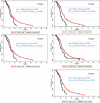Interest of integrins targeting in glioblastoma according to tumor heterogeneity and cancer stem cell paradigm: an update
- PMID: 29156849
- PMCID: PMC5689739
- DOI: 10.18632/oncotarget.20372
Interest of integrins targeting in glioblastoma according to tumor heterogeneity and cancer stem cell paradigm: an update
Abstract
Glioblastomas are malignant brain tumors with dismal prognosis despite standard treatment with surgery and radio/chemotherapy. These tumors are defined by an important cellular heterogeneity and notably contain a particular subpopulation of Glioblastoma-initiating cells, which recapitulate the heterogeneity of the original Glioblastoma. In order to classify these heterogeneous tumors, genomic profiling has also been undertaken to classify these heterogeneous tumors into several subtypes. Current research focuses on developing therapies, which could take into account this cellular and genomic heterogeneity. Among these targets, integrins are the subject of numerous studies since these extracellular matrix transmembrane receptors notably controls tumor invasion and progression. Moreover, some of these integrins are considered as membrane markers for the Glioblastoma-initiating cells subpopulation. We reviewed here integrin expression according to glioblastoma molecular subtypes and cell heterogeneity. We discussed their roles in glioblastoma invasion, angiogenesis, therapeutic resistance, stemness and microenvironment modulations, and provide an overview of clinical trials investigating integrins in glioblastomas. This review highlights that specific integrins could be identified as selective glioblastoma cells markers and that their targeting represents new diagnostic and/or therapeutic strategies.
Keywords: cancer stem cells; clinical trials; glioblastoma; integrins; targeted therapy.
Conflict of interest statement
CONFLICTS OF INTEREST None.
Figures





References
-
- Louis DN, Perry A, Reifenberger G, von Deimling A, Figarella-Branger D, Cavenee WK, Ohgaki H, Wiestler OD, Kleihues P, Ellison DW. The 2016 World Health Organization Classification of Tumors of the Central Nervous System: a summary. Acta Neuropathol. 2016;131:803–20. - PubMed
-
- Brandes AA, Tosoni A, Franceschi E, Reni M, Gatta G, Vecht C. Glioblastoma in adults. Crit Rev Oncol Hematol. 2008;67:139–52. - PubMed
-
- Weller M, van den Bent M, Hopkins K, Tonn JC, Stupp R, Falini A, Cohen-Jonathan-Moyal E, Frappaz D, Henriksson R, Balana C, Chinot O, Ram Z, Reifenberger G, et al. EANO guideline for the diagnosis and treatment of anaplastic gliomas and glioblastoma. Lancet Oncology. 2014;15:e395–403. - PubMed
-
- Karsy M, Guan J, Cohen AL, Jensen RL, Colman H. New Molecular Considerations for Glioma: IDH, ATRX, BRAF, TERT, H3 K27M. Curr Neurol Neurosci Rep. 2017;17:19. - PubMed
-
- Aldape K, Zadeh G, Mansouri S, Reifenberger G, von Deimling A. Glioblastoma: pathology, molecular mechanisms and markers. Acta Neuropathol. 2015;129:829–48. - PubMed
Publication types
LinkOut - more resources
Full Text Sources
Other Literature Sources

